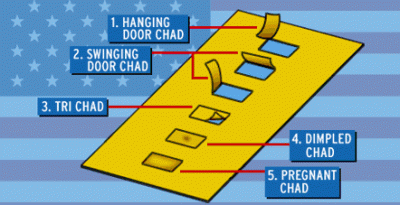
In the U.S. presidential election of 2000, there was chaos in the state of Florida where votes had to be recounted by hand due to a glitch in the voting machines. The voting machines used cards which had to be punched through for a vote to be registered. A mechanical problem meant that a huge number of cards were incompletely punched out, leaving the bits of paper called chads, ‘hanging’. Some cards had ‘dimpled’ or ‘pregnant’ chads meaning there was only a barely visible indentation!
Chads are the small pieces of paper produced when holes are punched out in a sheet. The bits punched out of tape, plastic, textile or thin metal are also called chads. Punch cards were once widely used in computer programming and the word ‘chad’ probably originated during that time. However, the earliest use of a punch card was in a fully automated weaving loom invented by Joseph Jacquard in 1801.
A number of manufacturing industries generate chads as waste. Since they are small and weigh almost nothing, managing chads is quite bothersome. Paper manufacturers have chad collectors under the punching table to collect the chads which are later recycled and made into new paper.
There are also ‘chad-less’ punching systems available which make slits in the paper instead of holes.
Picture Credit : Google










